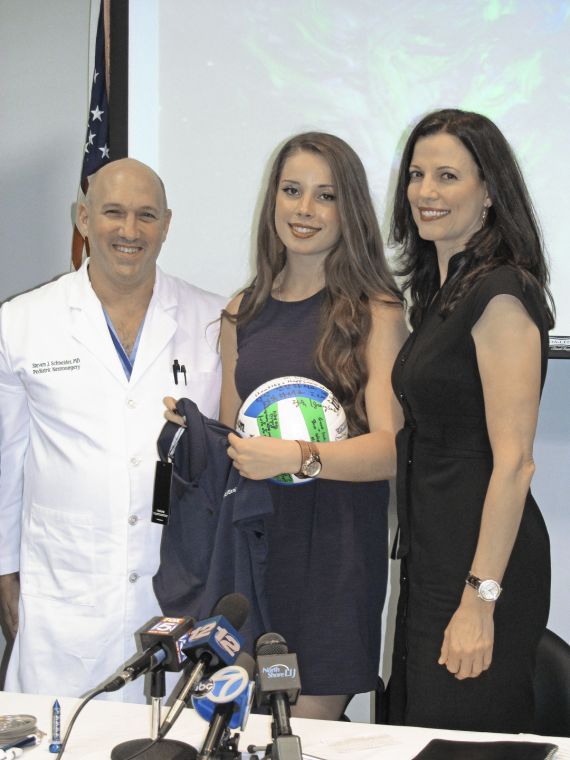When 15-year-old Blakely Murphy underwent her second surgery in four years to remove a brain tumor at Cohen Children’s Medical Center in April, she was confident of the outcome.
“I was not scared at all. If I could do it at 11, I knew I could do it at 15,” Blakely said. “My main concern was getting back to volleyball.”
The teenager from St. James was in the hands of the same physician who had performed her first surgery, Dr. Steven Schneider, a pediatric neurologist at the New Hyde Park-based Cohen Children’s Medical Center.
But this time around, Schneider used a new technology, Nico BrainPath, to enable the removal of a tumor that would otherwise have been inoperable.
“But for this technology, she would not be here as she is now,” Schneider said at a recent press conference at Long Island Jewish Medical Center about the new surgical technology.
In 2009, Blakely suffered a seizure during a basketball game, according to her mother, Dawn Murphy, who said she suspected her daughter had a brain tumor. She said her daughter and Schneider immediately formed a bond as they discussed surgical options at their first meeting.
“Blakely and Dr. Schneider hit it off,” Dawn Murphy said.
Blakely agreed to Schneider’s suggestion that the surgery be performed while she was awake, with one condition: that her hair not be shaved. He agreed and five days after he removed the tumor, she was back in school. Three months later, she was playing volleyball again.
But early this year, Blakely had a recurrence of seizures, accompanied by vomiting. A follow-up checkup with Schneider revealed that she had a second tumor embedded much deeper in her brain. It was a condition for which the Nico BrainPath technology had been developed, according to Schneider.
He said the BrainPath’s Myriad tool is shaped to go between the natural folds of the brain through an external sleeve used to guide it.
The Myriad, an automated tissue receptor, has a shaver connected to a piston on the end that enters the brain, enabling it to cut into the tumor, gather material from it and remove it from the brain, Schneider said.
He said the operating technology also employs fibrotrack “mapping” with a specialized MRI and GPS imaging. The surgeon operates with the Nico device hooked to a computer to show its precise position in the brain.
“This is the beginning of a new era in brain surgery,” Schneider said.
He said The Nico BrainPath technology has been in development by Indianapolis-based Nico Corp. for the past seven years and was approved by the Federal Drug Administration 18 months ago. He said the technology costs $700 for each procedure.
Jim Pearson, Nico’s chief executive officer, said the technology could eventually be used in intervention treatment for strokes.
North Shore-LIJ is one of first 14 medical institutions in the country to have the new technology.
Blakely’s surgery was delayed to enable her to play in a volleyball tournament, and then Schneider performed the procedure with the Nico technology to remove the golfball-sized tumor on April 22. She was awake for the more than 10-hour-long second surgery and has a clear memory of talking to Schneider about President Barack Obama, her favorite TV shows and her pets.
Each time he cut into the tumor, Schneider said, Blakely’s speech slowed down.
Her recovery time was quicker after the second brain surgery, going back home within 24 hours after the procedure and back to volleyball two weeks later.
“I owe them my life and how I am today,” Blakely said.
She said she aims to attend Adelphi University and play volleyball there, and after college she wants to become a psychologist.



